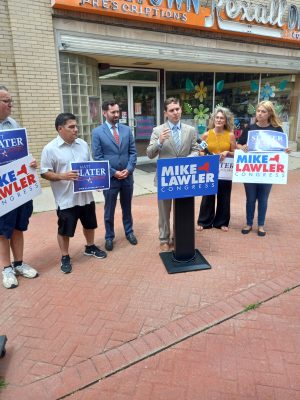Slater, Republican Congressional Hopeful Call for 2% State Spending Cap
News Based on facts, either observed and verified directly by the reporter, or reported and verified from knowledgeable sources.

Two Hudson Valley elected officials seeking higher office this fall have proposed a 2 percent state spending cap to curb what they characterize as runaway spending in Albany and make New York more affordable.
Yorktown Supervisor Matt Slater, the Republican nominee in the 94th Assembly District, and Assemblyman Mike Lawler (R-Pearl River), one of five GOP hopefuls in this year’s 17th Congressional District race, chided the Democratic-dominated state government for increasing spending by about $40 billion since 2018.
They cited a report released this week by state Comptroller Thomas DiNapoli calling the pace of spending “difficult to sustain” in the long term. The current fiscal year’s budget is about $220 billion while New York State has debt of about $290 billion.
“We really do need a state spending cap,” Slater said in front of Yorktown Pharmacy, one week after it was robbed in broad daylight and criticizing Democrats for the statewide uptick in crime.
“This has been an issue that’s been on the plate, on the agenda up in Albany for a number of years now, and under one-party rule they have failed to take any action,” Slater said of the Democrats. “The state spending cap would ensure responsible fiscal government, like we have done in the Town of Yorktown.”
A spending cap would work similarly to what municipalities and school districts have had to follow for the past decade, said Slater, who led a petition drive in May to urge lawmakers to enact a spending cap. Meanwhile, the state has refused to adhere to a tax cap that they can’t or won’t abide by, he said.
Lawler, attempting to tie congressional Democrats to the fiscal issue as well, said the state has irresponsibly spent money it has received from Washington, some of which has come for relief from COVID-19. The assemblyman said the Democrats’ fiscal policies at the federal and state levels have largely caused the financial pain families are experiencing in New York. The state, for example, appropriated more than $2 billion for the Excluded Workers Fund for largely undocumented people but only $100 million to help small businesses.
“Over the past two years because of COVID, in large part, the federal government has printed obscene amounts of money, which has led to record levels of inflation,” Lawler said. “This is the highest levels of inflation in over 40 years and New York State took that money, and rather than get its fiscal house in order has spent it on $40 billion in new spending with no plans on moving forward to secure our fiscal future.”
He also took the opportunity to swipe Rep. Sean Patrick Maloney (D-Cold Spring) and the Democrats for failing to lift the $10,000 limit on state and local tax deductions despite holding the White House and slim majorities in both houses of Congress.
Lawler said the state could be in trouble fiscally as soon as next year.
“New York State is going to face a reckoning next year because we have our leadership under one-party rule and that is why you need to restore balance at every level of government so that you can apply common-sense values and policies in dealing with our fiscal health,” Lawler said.
Messages left for Maloney’s campaign office to respond to Lawler’s comments regarding the SALT deduction were not returned on Thursday and Friday.
DiNapoli’s report, which was released on Wednesday, said the state projects fiscal stability for the next five years, but the effective administration of federal money and the need to bolster rainy day funds are critical.
However, a series of risks, including uncertainties regarding climate change and COVID-19 and federal policy and funding changes, could potentially be problematic for New York.
“Over the longer term, the elevated level of General Fund spending may be difficult to sustain as temporary resources are depleted or expire,” DiNapoli wrote. “Notably, the American Rescue Plan included $12.7 billion for New York State that may be used for a wide range of purposes, including to cover loss of revenues due to the economic impacts of COVID-19.”
While not addressing Slater and Lawler directly, Assemblyman Chris Burdick (D-Bedford) said most of the new spending since the pandemic has centered on initiatives that his constituents in the 93rd Assembly District and around the state wanted to see, including investment to fix crumbling roads and bridges and fully funding local school districts, much of it funded through the federal Build Back Better legislation approved last year.
“Our responsibility is to ensure the quality of life and the health and safety of our residents,” Burdick said.

Martin has more than 30 years experience covering local news in Westchester and Putnam counties, including a frequent focus on zoning and planning issues. He has been editor-in-chief of The Examiner since its inception in 2007. Read more from Martin’s editor-author bio here. Read Martin’s archived work here: https://www.theexaminernews.com/author/martin-wilbur2007/
